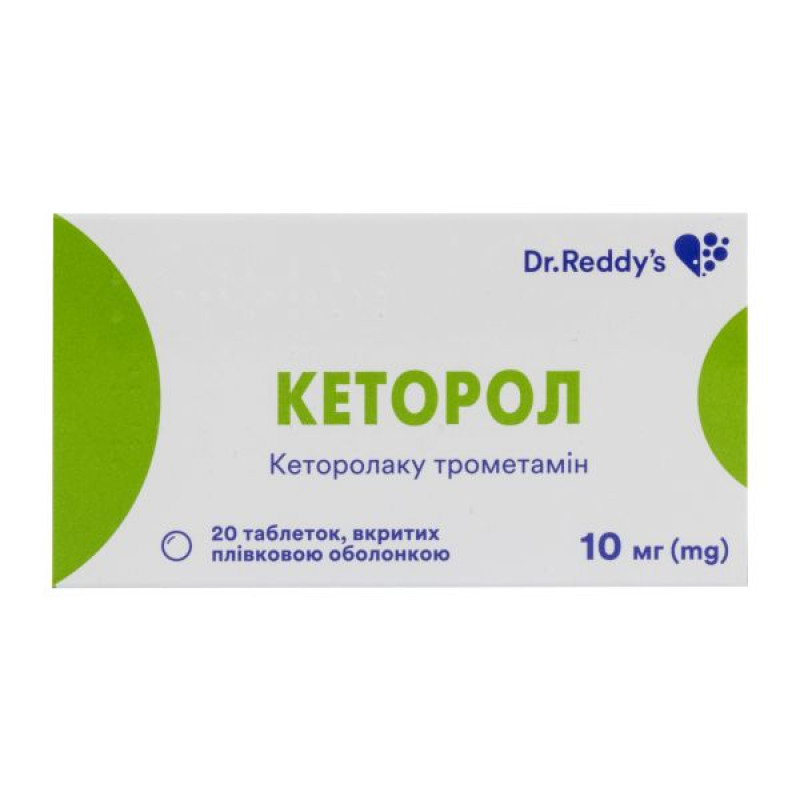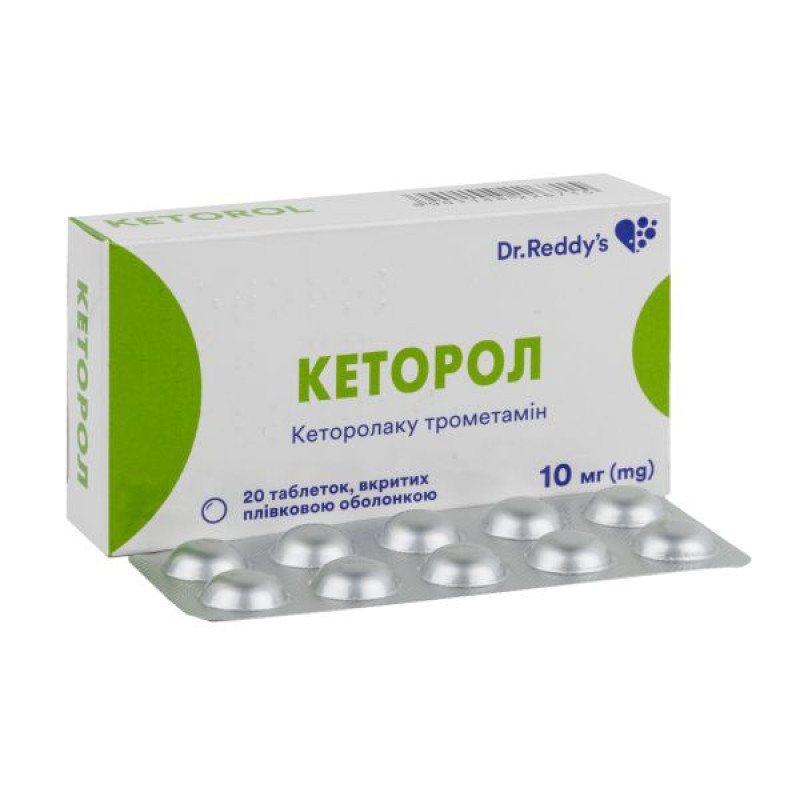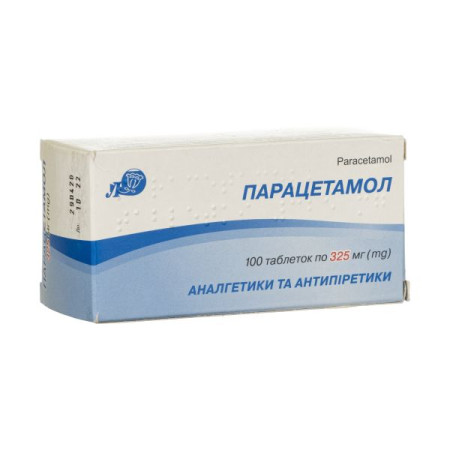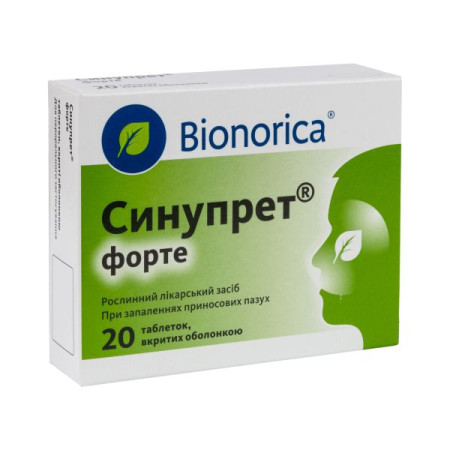Ketorol film-coated tablets 10 mg No. 20
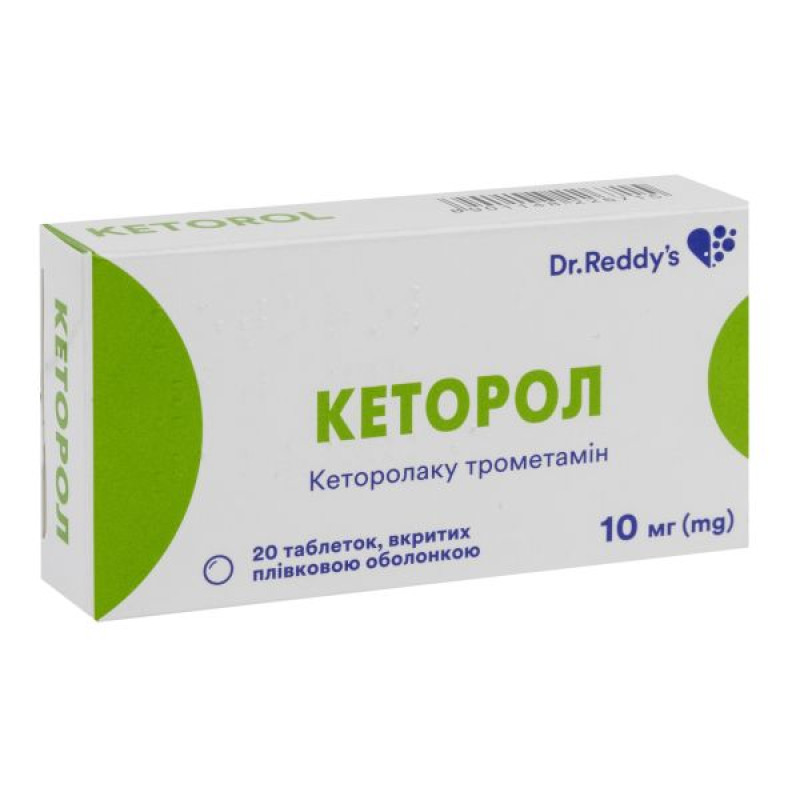
Instructions for Ketorol film-coated tablets 10 mg No. 20
Composition
active ingredient: ketorolac;
1 film-coated tablet contains ketorolac tromethamine 10 mg;
excipients: microcrystalline cellulose, pregelatinized starch, corn starch, colloidal anhydrous silicon dioxide, magnesium stearate, Opadry 03K51148 Green* film coating.
*Qualitative composition of the film coating: hypromellose, titanium dioxide (E 171), triacetin, triacetate, iron oxide yellow (E 172), diamond blue FCF (E 133).
Dosage form
Film-coated tablets.
Main physicochemical properties: tablets are round, biconvex, film-coated green, with the monogram "S" on one side and smooth on the other.
Pharmacotherapeutic group
Nonsteroidal anti-inflammatory and antirheumatic drugs.
ATX code M01A B15.
Pharmacological properties
Pharmacodynamics.
Ketorolac tromethamine is a non-narcotic analgesic. It is a non-steroidal anti-inflammatory drug that exhibits anti-inflammatory and weak antipyretic activity.
Ketorolac tromethamine inhibits prostaglandin synthesis and is considered a peripherally acting analgesic. It has no known effects on opiate receptors. No evidence of respiratory depression has been observed in controlled clinical trials following the use of ketorolac tromethamine. Ketorolac tromethamine does not cause mydriasis.
Pharmacokinetics.
Ketorolac tromethamine is rapidly and completely absorbed after oral administration with a peak plasma concentration of 0.87 μg/mL 50 min after a single 10 mg dose. In healthy volunteers, the terminal plasma half-life averages 5.4 hours. In elderly subjects (mean age 72 years), it is 6.2 hours. More than 99% of ketorolac in plasma is bound to blood proteins. In humans, the pharmacokinetics of ketorolac are linear after single or multiple doses. Steady-state plasma levels are achieved within 1 day when administered 4 times daily. No changes were observed with long-term dosing. After a single intravenous dose, the volume of distribution is 0.25 L/kg, the half-life is 5 hours, and the clearance is 0.55 mL/min/kg. The main route of excretion of ketorolac and its metabolites (conjugates and p-hydroxymetabolites) is urine (91.4%), with the remainder excreted in feces. A high-fat diet reduces the rate of absorption, but not the extent, while antacids do not affect the absorption of ketorolac.
Indication
Short-term treatment of moderate pain, including postoperative pain.
Contraindication
Hypersensitivity to ketorolac or to any component of the drug;
- patients with active peptic ulcer, recent gastrointestinal bleeding or perforation, or a history of peptic ulcer or gastrointestinal bleeding;
- bronchial asthma, rhinitis, angioedema or urticaria caused by the use of acetylsalicylic acid or other non-steroidal anti-inflammatory drugs (due to the possibility of severe anaphylactic reactions);
- history of bronchial asthma;
- do not use as an analgesic before and during surgery;
- severe heart failure;
- complete or partial syndrome of nasal polyps, angioedema or bronchospasm;
- do not use in patients who have had surgery with a high risk of hemorrhage or incomplete bleeding and in patients receiving anticoagulants, including low doses of heparin (2500-5000 units every 12 hours);
- hepatic or moderate to severe renal failure (serum creatinine clearance more than 160 μmol/l);
- suspected or confirmed cerebrovascular bleeding, hemorrhagic diathesis, including blood clotting disorders and high risk of bleeding;
- concomitant treatment with other non-steroidal anti-inflammatory drugs (NSAIDs) (including selective cyclooxygenase inhibitors), acetylsalicylic acid, warfarin, pentoxifylline, probenecid or lithium salts;
- hypovolemia, dehydration;
- patients at risk of renal failure due to volume depletion;
- the period of pregnancy, labor, childbirth and breastfeeding;
- children under 16 years of age.
Interaction with other medicinal products and other types of interactions
Ketorolac is readily bound to plasma proteins (mean 99.2%), and the extent of binding is concentration-dependent. Concomitant administration with food reduces the rate of absorption but does not affect the extent of ketorolac absorption.
Cannot be used simultaneously with ketorolac.
Due to the possibility of side effects, ketorolac should not be administered with other NSAIDs, including selective cyclooxygenase-2 inhibitors, or to patients receiving acetylsalicylic acid, warfarin, lithium, probenecid, cyclosporine. NSAIDs should not be administered within 8-12 days after mifepristone administration, as NSAIDs may weaken the effect of mifepristone.
In normal healthy subjects with normovolemia, ketorolac reduces the diuretic effect of furosemide by approximately 20%, therefore, special care should be taken when prescribing the drug to patients with cardiac decompensation. NSAIDs can aggravate heart failure, reduce glomerular filtration rate and increase plasma levels of cardiac glycosides when used concomitantly with cardiac glycosides. Ketorolac and other nonsteroidal anti-inflammatory drugs can weaken the effect of antihypertensive drugs. When ketorolac is used concomitantly with ACE inhibitors, there is an increased risk of renal dysfunction, especially in patients with reduced blood volume in the body. There is a possible risk of nephrotoxicity if NSAIDs are prescribed together with tacrolimus. Simultaneous administration with diuretics may lead to a weakening of the diuretic effect and an increased risk of nephrotoxicity of NSAIDs. As with all NSAIDs, caution should be exercised when corticosteroids are administered concomitantly due to the increased risk of gastrointestinal ulceration or bleeding. There is an increased risk of gastrointestinal bleeding when NSAIDs are administered in combination with antiplatelet agents and selective serotonin reuptake inhibitors. Caution is advised when methotrexate is administered concomitantly, as some prostaglandin synthesis inhibitors have been reported to reduce the clearance of methotrexate and therefore possibly increase its toxicity. Patients taking NSAIDs and quinolones may be at increased risk of convulsions. Concomitant use of NSAIDs with zidovudine increases the risk of haematological toxicity. There is an increased risk of haemarthrosis and haematoma in HIV-infected patients with haemophilia treated concomitantly with zidovudine and ibuprofen.
The following drugs are unlikely to interact with ketorolac.
Ketorolac did not affect the plasma protein binding of digoxin. In vitro studies indicate that at therapeutic concentrations of salicylate (300 μg/mL) and above, ketorolac binding was reduced from approximately 99.2% to 97.5%. Therapeutic concentrations of digoxin, warfarin, paracetamol, phenytoin, and tolbutamide did not affect the plasma protein binding of ketorolac. Since ketorolac is a highly active drug and its available plasma concentrations are low, it is not expected to significantly displace other drugs that are bound to plasma proteins. In animal and human studies, there was no evidence that ketorolac tromethamine induces or inhibits hepatic enzymes capable of metabolizing it or other drugs. Therefore, ketorolac is not expected to alter the pharmacokinetics of other drugs through enzyme induction or inhibition.
Antiepileptic drugs.
Isolated cases of epileptic seizures have been reported during the concomitant use of ketorolac and antiepileptic drugs (phenytoin, carbamazepine).
Psychotropic drugs.
Hallucinations have been reported with the simultaneous use of ketorolac and psychotropic drugs (fluoxetine, thiotexene, alprazolam).
Impact on laboratory test results.
Ketorolac inhibits platelet aggregation and may prolong bleeding time.
Application features
The maximum duration of treatment should not exceed 7 days.
Impact on fertility.
The use of ketorolac, as with any drug that inhibits cyclooxygenase/prostaglandin synthesis, may impair fertility and is not recommended in women attempting to conceive. For women who are unable to conceive or are undergoing investigation of fertility, discontinuation of ketorolac should be considered.
Gastrointestinal bleeding, ulceration and perforation.
Gastrointestinal bleeding, ulceration or perforation, which can be fatal, has been reported with NSAIDs at any time during treatment, with or without warning symptoms or a history of severe gastrointestinal disorders. The risk of serious gastrointestinal bleeding is dose-dependent. This is particularly true in elderly patients receiving ketorolac at an average daily dose of more than 60 mg. For these patients, as well as for patients taking low-dose acetylsalicylic acid or other drugs that may increase the risk for the gastrointestinal tract, combination therapy with protective agents (e.g. misoprostol or proton pump inhibitors) should be considered. Ketorolac should be used with caution in patients receiving concomitant medications that may increase the risk of ulceration or bleeding, such as oral corticosteroids, selective serotonin reuptake inhibitors, or antiplatelet agents such as acetylsalicylic acid. If gastrointestinal bleeding or ulceration occurs in patients receiving ketorolac, treatment should be discontinued.
Respiratory dysfunction.
Caution is required when using the drug in patients with bronchial asthma (or with a history of bronchial asthma), since NSAIDs have been reported to precipitate bronchospasm in such patients.
Prostaglandin biosynthesis inhibitors (including NSAIDs) have been reported to be nephrotoxic. Caution should be exercised in patients with renal, cardiac, or hepatic impairment, as NSAIDs may worsen renal function. Patients with mild renal impairment should be given lower doses of ketorolac (not to exceed 60 mg/day intramuscularly or intravenously) and their renal function should be closely monitored. As with other prostaglandin synthesis inhibitors, increases in serum urea, creatinine, and potassium have been reported with ketorolac tromethamine, which may occur after a single dose.
Disorders of the cardiovascular system, kidneys and liver.
Caution should be exercised in patients with conditions that result in decreased blood volume and/or renal blood flow, where renal prostaglandins play a supporting role in maintaining renal perfusion. Renal function should be monitored in these patients. Volume depletion should be corrected and serum urea and creatinine and urine output should be closely monitored until the patient is normovolemic. In patients on renal dialysis, ketorolac clearance was reduced to approximately half the normal rate and the terminal half-life was increased to approximately threefold. Patients with hepatic impairment due to cirrhosis did not have any clinically significant changes in ketorolac clearance or terminal half-life. Borderline elevations in one or more liver function tests may occur. These abnormalities may be transient, may remain unchanged, or may progress with continued treatment. If clinical signs and symptoms suggest the development of liver disease or if systemic manifestations are observed, ketorolac should be discontinued.
Fluid retention and swelling.
Fluid retention and edema have been reported with ketorolac, so it should be administered with caution to patients with cardiac decompensation, hypertension, or similar conditions.
Cardiovascular and cerebrovascular effects.
There is currently insufficient information to assess this risk for ketorolac tromethamine. Patients with uncontrolled hypertension, congestive heart failure, established ischemic heart disease, peripheral arterial disease, and/or cerebrovascular disease should be monitored by a physician.
Systemic lupus erythematosus and mixed connective tissue diseases.
Patients with systemic lupus erythematosus and various mixed connective tissue diseases are at increased risk of developing aseptic meningitis.
Dermatological.
Ketorolac should be discontinued at the first sign of skin rash, mucosal lesions, or any other sign of hypersensitivity.
Hematological effects.
Patients with bleeding disorders should not be given ketorolac. Patients receiving anticoagulant therapy may be at increased risk of bleeding if ketorolac is used concomitantly. Patients receiving other drugs that may affect the rate of bleeding should be carefully monitored when ketorolac is given. In controlled clinical trials, the incidence of major postoperative bleeding was less than 1%. Ketorolac inhibits platelet aggregation and prolongs bleeding time. In patients with normal bleeding times, bleeding time was increased but did not exceed the normal range of 2-11 minutes. In contrast to the prolonged effect of acetylsalicylic acid, platelet function returns to normal within 24-48 hours after ketorolac discontinuation. Ketorolac should not be given to patients who have undergone surgery with a high risk of bleeding or incomplete bleeding. Caution should be exercised if mandatory control of bleeding is critical. Ketorolac is not an anesthetic and does not have sedative or anxiolytic properties, therefore it is not recommended as a premedication before surgery to maintain anesthesia.
Hypovolemia should be corrected before initiating ketorolac.
Use during pregnancy or breastfeeding
The safety of ketorolac during human pregnancy has not been established. Given the known effects of NSAIDs on the fetal cardiovascular system (risk of premature closure of the ductus arteriosus), ketorolac is contraindicated during pregnancy, labor and delivery. The onset of labor may be delayed and the duration prolonged with an increased tendency for bleeding in both mother and child.
Ketorolac passes into breast milk at low levels, so the drug is contraindicated during breastfeeding.
Ability to influence reaction speed when driving vehicles or other mechanisms
Some patients may experience drowsiness, dizziness, vertigo, insomnia, fatigue, visual disturbances, or depression when taking ketorolac. If patients experience these or similar side effects, they should not drive or operate machinery.
It is advisable to take the tablets during or after meals. The drug is recommended for short-term use only (up to 7 days). In order to minimize side effects, the drug should be used in the lowest effective dose for the shortest period of time necessary to control symptoms. Before starting treatment, normovolemia should be achieved. Adults should be prescribed ketorolac 10 mg every 4-6 hours if necessary. It is not recommended to use the drug in doses exceeding 40 mg per day. Opioid analgesics (e.g. morphine, pethidine) can be used in parallel, ketorolac does not affect the binding of opioid drugs and does not enhance the respiratory depression or sedative effect of opioids. For patients receiving parenteral ketorolac and who are prescribed ketorolac orally in tablet form, the total combined daily dose should not exceed 90 mg (60 mg for the elderly, patients with renal impairment, and patients weighing less than 50 kg), and the oral dosage should not exceed 40 mg per day if the dosage form is changed. Patients should be switched to oral administration as soon as possible.
Elderly patients.
Elderly patients are at greater risk of developing serious complications, particularly from the digestive tract. During treatment with NSAIDs, the patient's condition should be regularly monitored, and a longer interval between doses, such as 6-8 hours, is usually recommended.
Children: Do not use in children under 16 years of age.
Overdose
Symptoms: headache, nausea, vomiting, epigastric pain, gastrointestinal bleeding; rarely - diarrhea, disorientation, agitation, coma, drowsiness, dizziness, tinnitus, loss of consciousness, sometimes convulsions. In cases of severe poisoning, acute renal failure and liver damage are possible. Metabolic acidosis has been observed after intentional overdose.
Treatment: gastric lavage, administration of activated charcoal. Adequate diuresis should be ensured. Renal and hepatic function should be closely monitored. Patients should be observed for at least 4 hours after ingestion of a potentially toxic amount. Frequent or prolonged convulsions should be treated with intravenous diazepam. Other measures may be prescribed depending on the clinical condition of the patient. Treatment is symptomatic. Dialysis does not remove ketorolac from the circulation.
Adverse reactions
Gastrointestinal: peptic ulcer, perforation or gastrointestinal bleeding, sometimes fatal (especially in elderly patients), nausea, dyspepsia, gastrointestinal pain, abdominal discomfort, bloody vomiting, gastritis, esophagitis, diarrhea, belching, constipation, flatulence, feeling of fullness of the stomach, melena, rectal bleeding, ulcerative stomatitis, vomiting, hemorrhages, perforation, pancreatitis, exacerbation of colitis and Crohn's disease.
Central nervous system: anxiety, visual disturbances, optic neuritis, drowsiness, dizziness, headache, increased sweating, dry mouth, nervousness, paresthesia, functional disorders, depression, euphoria, convulsions, increased thirst, inability to concentrate, insomnia, malaise, increased fatigue, agitation, vertigo, taste and vision disorders, myalgia, unusual dreams, confusion, hallucinations, hyperkinesia, hearing loss, tinnitus, aseptic meningitis with corresponding symptoms, psychotic reactions, thinking disorders.
From the urinary system: increased urinary frequency, oliguria, acute renal failure
insufficiency, hyponatremia, hyperkalemia, hemolytic uremic syndrome, flank pain (with/without hematuria), increased serum urea and creatinine, interstitial nephritis, urinary retention, nephrotic syndrome, infertility, renal failure.
Hepatic: liver dysfunction, hepatitis, jaundice and hepatic failure.
Cardiovascular system: hot flashes, bradycardia, pallor, hypertension, palpitations, chest pain, edema, heart failure.
Clinical and epidemiological data suggest that the use of some NSAIDs, especially in high doses and for long periods, may be associated with an increased risk of arterial thromboembolic complications (myocardial infarction or stroke).
Respiratory system: shortness of breath, bronchial asthma, pulmonary edema.
From the blood system: purpura, thrombocytopenia, neutropenia, agranulocytosis, aplastic and hemolytic anemia, hematoma, prolonged bleeding time.
Hypersensitivity: Hypersensitivity reactions including non-specific allergic reactions and anaphylaxis, respiratory tract reactivity including bronchial asthma, worsening of bronchial asthma, bronchospasm, laryngeal edema or dyspnea, and skin disorders including rashes of various types, pruritus, urticaria, purpura, angioedema and, in rare cases, exfoliative and bullous dermatitis (including epidermal necrolysis and erythema multiforme) have been reported.
Such reactions may occur in patients with or without known hypersensitivity to ketorolac or other NSAIDs. They may also occur in individuals with a history of angioedema, bronchospastic reactivity (e.g., bronchial asthma and nasal polyps). Anaphylactoid reactions, such as anaphylaxis, may be fatal.
Others: postoperative wound bleeding, hematoma, nosebleed, prolonged bleeding time, asthenia, edema, weight gain, fever.
Expiration date
3 years.
Storage conditions
Store in the original packaging out of the reach of children at a temperature not exceeding 25 ºС.
Packaging
10 tablets in an aluminum-aluminum (Alu-Alu) blister. 2 blisters per pack.
Vacation category
According to the recipe.
Producer
Dr. Reddy's Laboratories Ltd., India.
Location of the manufacturer and its business address
Station No. 42, 45, 46, Bachupalli Village, Kutbulapur Mandal, Ranga Reddy District, Andhra Pradesh, India.
There are no reviews for this product.
There are no reviews for this product, be the first to leave your review.
No questions about this product, be the first and ask your question.







